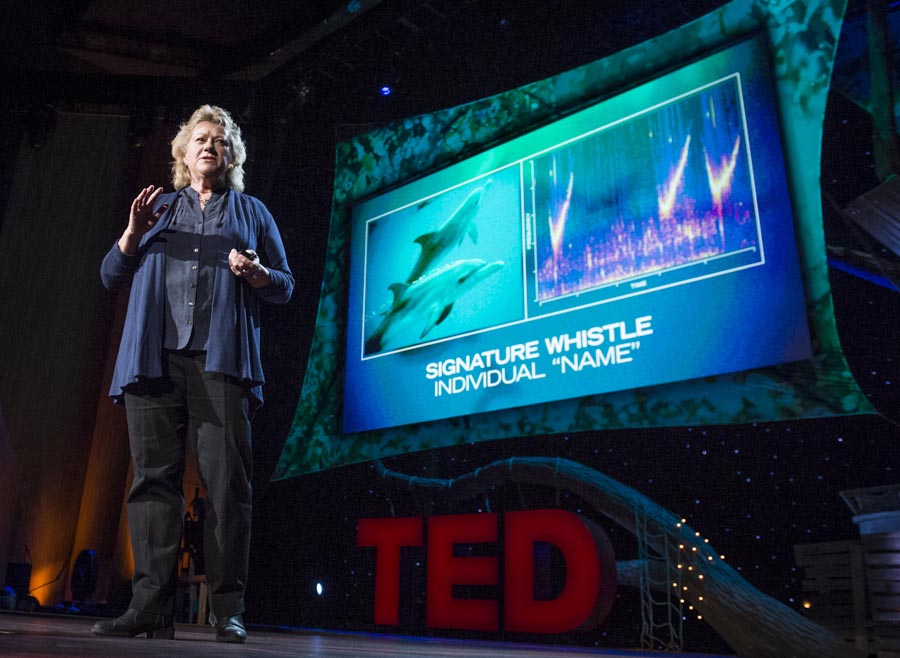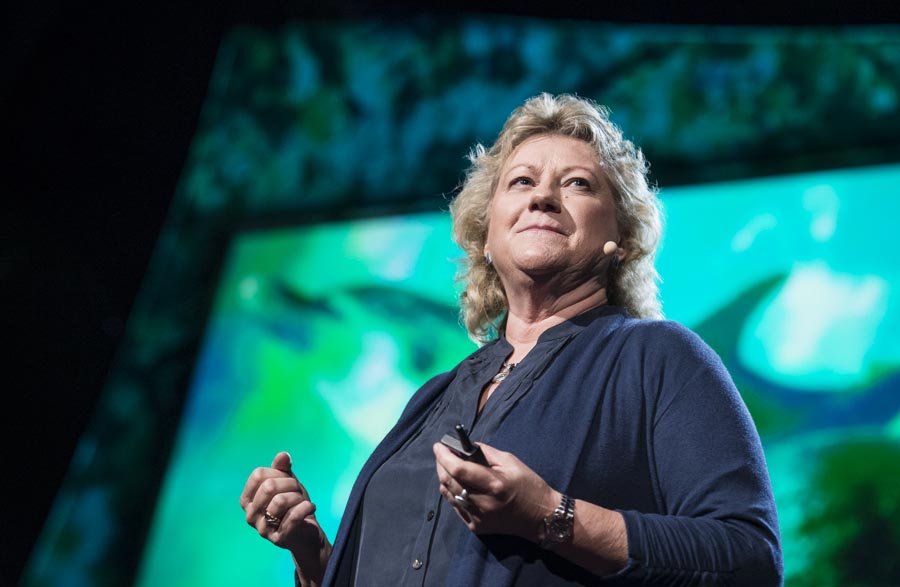A dolphin’s brain-to-body-weight ratio is second only to a human’s. They live complex social lives, can understand abstract concepts and even use tools. But as Denise Herzing asks in Session 8 of TED2013, “Do they have a language? If so, what are they talking about?”
For 28 years, Herzing has been researching dolphins in the wild, spending five months each summer living, sleeping and working at sea off the coast of the Bahamas with a pod of Atlantic spotted dolphins. It’s the mission of her Wild Dolphin Project. These dolphins can live to their early 50s and, at this point, Herzing and her team are tracking three generations of the pod.
Dolphins, of course, are incredible mammals. They have many ways to communicate with each other — including body language, touch and sound. In addition to their much-heralded echolocation, which they use for hunting and feeding, each dolphin has a signature whistle, which appears to function sort of like a name. Dolphins also buzz and tickle each other from afar. The different buzzes appear to have different social meanings. For example, a tightly packed buzz appears to be a dolphin’s version of sexual inuendo. “I’ve been buzzed in the water,” says Herzing. “Don’t tell anyone.”
Dolphins use sound to resolve conflicts, creating burst pulses to show agression. And if you watch a pod swim together, they begin to mirror each other’s body positions. They use the synchronicity of both sounds and body positions to cement relationships.
Still, does the way dolphins communication count as a language? Herzing says that many of the burst pulses made by dolphins — while they appear to be a bit like human phonemes — they are still a bit of a mystery. Herzing wondered if, because her team had a special relationships with the dolphin, they might be able to create an interface for two-way communication between themselves and the dolphins.
“The dolphins were showing a lot of mutual curiosity about us. They were mimicking our vocal sounds and inviting us into their dolphin games,” says Herzing. “We thought, ‘Wouldn’t it be neat to build a technology for the dolphins to request their favorite toys in real time?'”
 To test human-dolphin communication, Herzing and a team created a keyboard with four symbols, which corresponded with acoustic sounds and with a toy. The keyboard worked — the dolphins learned to respond to the sounds by bringing the appropriate toy.
To test human-dolphin communication, Herzing and a team created a keyboard with four symbols, which corresponded with acoustic sounds and with a toy. The keyboard worked — the dolphins learned to respond to the sounds by bringing the appropriate toy.
On the TED stage, Herzing shows amazing footage of a dolphin swimming a scarf to a researcher, on her request. Herzing says of this dolphin, “We call her the scarf thief because, over the years, she’s made off with a lot of scarfs. We think she’s opened a boutique somewhere in The Bahamas.”
After four years working with this rudimentary keyboard, Herzing and her team realized that they needed more sophisticated technology. So they worked with a researcher at the Georgia Institute of Technology to build a wearable computer called CHAT. Still in the prototype stage, this wearable computer is “designed to empower the dolphins to request things from us.” It even lets a dolphin request an object from a specific diver.
Herzing is excited to see how this new tool changes communication with the dolphins.
“Will they learn to make the whistles? We hope so … dolphins are excellent vocal mimics,” she says, before concluding her talk. “Imagine what it would be like to really understand another intelligent species on this planet.”
Denise Herzing’s talk is now available for viewing. Watch it on TED.com »

Comments (10)
Pingback: An Elephant in Tanzania Would Like to Skype with You | the history of art and technology
Pingback: TED2013: Interspecies Internet?
Pingback: Cymatics- How Dolphins use sound to see beyond sight
Pingback: What dolphins taught me about fear — Women On Fire
Pingback: The Disappearing Interface - Liz Gannes - News - AllThingsD
Pingback: The Disappearing Interface | MattsLens
Pingback: The interspecies internet
Pingback: The interspecies internet: Diana Reiss, Peter Gabriel, Neil Gershenfeld and Vint Cerf at TED2013 (TED) | Uma (in)certa antropologia
Pingback: The interspecies internet: Diana Reiss, Peter Gabriel, Neil Gershenfeld and Vint Cerf at TED2013 | LiMiT